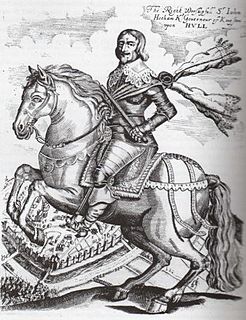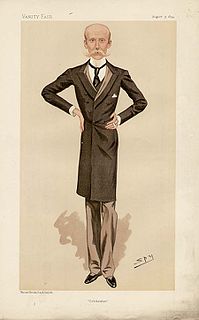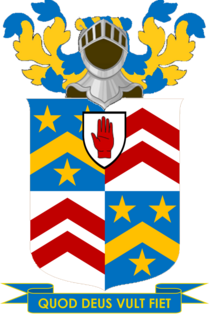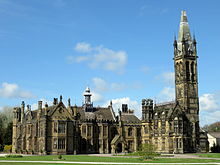
Baron Talbot of Malahide is a title that has been created twice for members of the same family—in 1831 in the Peerage of Ireland as Baron Talbot of Malahide, and in 1856 in the Peerage of the United Kingdom as Baron Talbot de Malahide. While the barony of 1856 became extinct in 1973, the barony of 1831 is extant. The ancestral seat of the family until 1976 was Malahide Castle, close to the village of that name, north of Dublin, Ireland.

Baron Hesketh, of Hesketh in the County Palatine of Lancaster, is a title in the Peerage of the United Kingdom. It was created in 1935 for Sir Thomas Fermor-Hesketh, 8th Baronet, who had previously briefly represented Enfield in the House of Commons as a Conservative. As of 2010 the titles are held by his grandson, the third Baron, who succeeded his father in 1955. Lord Hesketh held junior ministerial positions in the Conservative administrations of Margaret Thatcher and John Major. However, he lost his seat in the House of Lords after the House of Lords Act 1999 removed the automatic right of hereditary peers to sit in the upper chamber of Parliament.

Baron Clitheroe of Downham in the County of Lancaster is a title in the Peerage of the United Kingdom. It was created in the 1955 Birthday Honours for the Conservative politician Ralph Assheton, who had previously served as Financial Secretary to the Treasury. He was the son of Ralph Cockayne Assheton, for many years a member of the Lancashire County Council, who had been created baronet of Downham in the County of Lancaster, on 4 September 1945. Three months after being raised to the peerage, Lord Clitheroe succeeded his father in the baronetcy. As of 2017, the titles are held by the first Baron's son, the second Baron, who succeeded in 1984.

The Parliamentary Secretary to the Treasury is a senior ministerial position in the British Government. However, the office is now attached to the Treasury in name only; the holder is typically also the Chief Whip of the House of Commons. The office can be seen as a sinecure, in order to allow the chief whip to draw a Government salary, attend Cabinet, and use a Downing Street residence, traditionally 12 Downing Street.
Earl of Sussex is a title that has been created several times in the Peerages of England, Great Britain, and the United Kingdom. The early Earls of Arundel were often also called Earls of Sussex.

George Talbot, 6th Earl of Shrewsbury, 6th Earl of Waterford, 12th Baron Talbot, KG, Earl Marshal was an English magnate and military commander. He also held the subsidiary titles of 15th Baron Strange of Blackmere and 11th Baron Furnivall. He was best known for his tenure as keeper of Mary, Queen of Scots between 1568 – 1585, his marriage to his second wife Elizabeth Talbot, as well as his surviving collection of written work.

Scarisbrick Hall is a country house situated just to the south-east of the village of Scarisbrick in Lancashire, England.
The Clifford-Constable Baronetcy, of Tixall in the County of Staffordshire was given to Thomas Hugh Clifford-Constable, originally Thomas Hugh Constable Clifford. The title in the Baronetage of the United Kingdom was created on 22 May 1815 and at the request of Louis XVIII of France.

The Sheriff is the oldest secular office under the Crown. Formerly the Sheriff was the principal law enforcement officer in the county but over the centuries most of the responsibilities associated with the post have been transferred elsewhere or are now defunct, so that its functions are now largely ceremonial.

There have been nine baronetcies held by people with the surname Nugent, four in the Baronetage of Ireland and five in the Baronetage of the United Kingdom. Six of the creations are extinct, while three are extant.
There have been three baronetcies created for persons with the surname Power, all in the Baronetage of the United Kingdom.
The Naylor-Leyland Baronetcy, of Hyde Park House, Albert Gate, in the County of London, is a title in the Baronetage of the United Kingdom. It was created on 31 August 1895 for Herbert Naylor-Leyland, Conservative Member of Parliament for Colchester from 1892 to 1895 and Liberal Member of Parliament for Southport from 1898 to 1899. The second Baronet served as Sheriff of Denbighshire in 1921.

Sir Herbert Scarisbrick Naylor-Leyland, 1st Baronet, was a British politician.
There have been three baronetcies created for persons with the surname Hare, one in the Baronetage of England and two in the Baronetage of the United Kingdom. One creation is extant as of 2007.

The High Sheriff of Lancashire is an ancient officer, now largely ceremonial, granted to Lancashire, a county in North West England. High Shrievalties are the oldest secular titles under the Crown, in England and Wales. The High Sheriff of Lancashire is the representative of the monarch in the county, and is the "Keeper of The Queen's Peace" in the county, executing judgements of the High Court through an Under Sheriff.

The Chetwynd Baronetcy, of Brocton Hall in the County of Stafford, is a title in the Baronetage of Great Britain. It was created on 1 May 1795 for Sir George Chetwynd, Kt., of Brocton Hall, Staffordshire, for many years Clerk to the Privy Council. The second Baronet was Member of Parliament for Stafford and High Sheriff of Warwickshire in 1828. The fourth Baronet served as High Sheriff of Warwickshire in 1875. As of 13 June 2007 the presumed ninth Baronet has not successfully proven his succession and is therefore not on the Official Roll of the Baronetage, with the baronetcy dormant since 2004.

Sir Tom Talbot Leyland Scarisbrick, 1st Baronet was a British Liberal Party politician.
The High Sheriff of Wexford was the British Crown's judicial representative in County Wexford, Ireland from the 16th century until 1922, when the office was abolished in the new Irish Free State and replaced by the office of Wexford County Sheriff. The sheriff had judicial, electoral, ceremonial and administrative functions and executed High Court Writs. In 1908, an Order in Council made the Lord-Lieutenant the Sovereign's prime representative in a county and reduced the High Sheriff's precedence. However, the sheriff retained his responsibilities for the preservation of law and order in the county. The usual procedure for appointing the sheriff from 1660 onwards was that three persons were nominated at the beginning of each year from the county and the Lord Lieutenant then appointed his choice as High Sheriff for the remainder of the year. Often the other nominees were appointed as under-sheriffs. Sometimes a sheriff did not fulfil his entire term through death or other event and another sheriff was then appointed for the remainder of the year. The dates given hereunder are the dates of appointment. All addresses are in County Wexford unless stated otherwise.
Sir Philip Naylor-Leyland, 4th Baronet is a British aristocrat, landowner and hotelier.
Scarisbrick, also found as Scarsbrick, Scarsbrook, Scaysbrook, Scarasbrick and Scarrisbrick, is a toponymic surname of English origin, derived from the parish of Scarisbrick in Lancashire.












